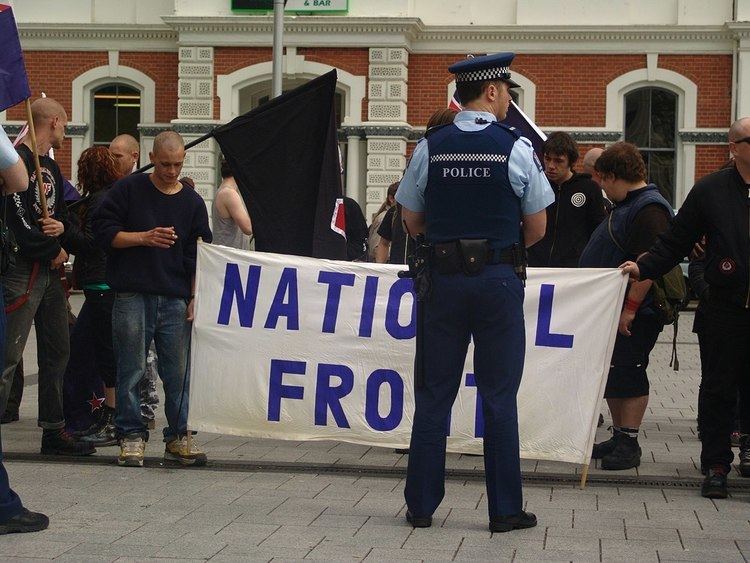Colors Blue | Founded 1968 | |
 | ||
The New Zealand National Front is a small white nationalist political party in New Zealand.
Contents
First formation
Mirroring developments in the UK, a group called the National Front evolved from the New Zealand branch of the League of Empire Loyalists in 1967. It was led by Brian Thompson; another notable member was Roger Clare who would later become an activist with the League of St George. It published a magazine called Counter-attack. The group dissolved by the beginning of the 1970s. Thompson remained an overseas supporter of the UK National Front.
Official organisation
The National Front of New Zealand, commonly known as the "New Zealand National Front" (NZNF), was an initiative of John Tyndall of the British National Front formed in 1977; sister organisations were also formed in Australia and South Africa at the same time.
The party's first chairman was David Crawford aided by Brian Thompson. Kerry Bolton joined in 1978. It distributed "large numbers of Holocaust denial pamphlets and books". Thompson represented the party at the march in Lewisham in 1977. The party encouraged its activists to infiltrate mainstream parties such as the National Party. The organisation became moribund during the early 1980s; many of its members left to form the 'New Force' which Bolton formed in 1981.
From June 1978 the party jointly published a magazine called Frontline with the National Front of Australia. After the demise of the party, the magazine continued to March 1987 in support of a more general non-party "nationalist cause".
Current party
In 1989 Anton Foljambe sought to revive the Frontline title for his "Conservative Front" grouping. This led to the reformation of the NZNF with Foljambe as leader. It published a magazine, edited by Foljambe, called Viewpoint. Foljambe resigned as leader in 1997 and established the rival National Democrats Party in 1999. Kyle Chapman then led the party until resigning as leader in 2005. Bolton rejoined the party in 2004. Since 2008 the party has been led by Colin Ansell. Answell stated that the party was to be a "broad spectrum nationalist movement" with a "strong view on immigration"
In June 2008, the party joined forces with the National Democrats and another international organisation, the 'New Right', to jointly contest the 2008 elections as the Nationalist Alliance.
Federal leaders
Shown by default in chronological order of leadershipSupport
The National Front has received a small amount of public support. 1.9% or 1,665 people (1.9% of the total) voted for Kyle Chapman in the 2004 Christchurch mayoral election. He placed fifth out of ten candidates.
Activities
On 23 October 2004, the National Front held a protest in Wellington to support retaining the current New Zealand flag, which was attended by an estimated 45 people. An 800-strong counter-demonstration was organised by the MultiCultural Aotearoa coalition and anarchists to expose the sympathies of the National Front. According to the New Zealand Herald, Chapman complained the following day of "insufficient police protection". This "Flag Day Rally" has now become an annual event, with NF members and protesters squaring off outside parliament.
In 2004 the NZNF reformed the National Front Australia.
The National Front claimed to have benefitted from favourable media coverage: Kyle Chapman told the Dominion newspaper that "the media is our best recruiter". National Radio host Linda Clark, claiming the need to "give a voice to all New Zealanders", has interviewed Chapman and Australian One Nation founder Pauline Hanson.
Policies
According to Te Ara: The Encyclopedia of New Zealand, the discernible policies of the National Front are "homophobia, racism and patriotic nationalism."
